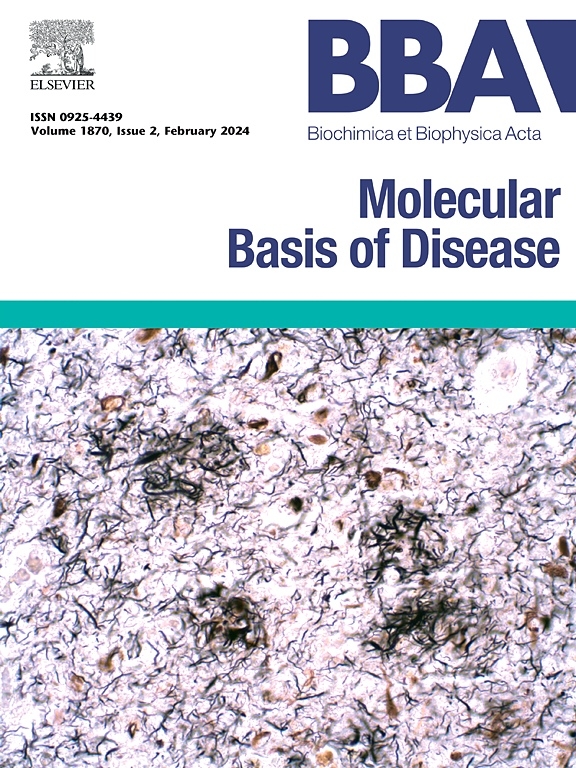GALNT4 controls aortic dissection by regulating vascular smooth muscle cell phenotype switch and dysfunction through the TGF-β/smad signaling
IF 4.2
2区 生物学
Q2 BIOCHEMISTRY & MOLECULAR BIOLOGY
Biochimica et biophysica acta. Molecular basis of disease
Pub Date : 2025-07-02
DOI:10.1016/j.bbadis.2025.167969
引用次数: 0
Abstract
Aortic dissection (AD) is a life-threatening vascular disorder whose underlying molecular mechanisms remain poorly understood. Polypeptide N-acetylgalactosaminyltransferase 4 (GALNT4), an enzyme that transfers N-acetylgalactosamine (GalNAc) to serine and threonine residues on target proteins, has been implicated in the development of cardiovascular diseases. However, its specific role in AD remains unclear. This study analyzed GALNT4 expression in human AD tissues and murine AD models induced by β-aminopropionitrile (BAPN) and angiotensin II (Ang II). Results revealed significantly elevated GALNT4 expression in the arteries of both human AD patients and AD mice (P < 0.01). Specifically, GALNT4 levels in vascular smooth muscle cells (VSMCs) from human and mouse AD arteries were markedly higher than in normal arteries. Smooth muscle cell (SMC)-specific knockdown of GALNT4 reduced AD incidence (53.8 % vs. 76.9 %) and rupture rates (28.6 % vs. 70.0 %), while improving AD pathology. This improvement was characterized by preserved contractile markers (α-SMA, SM22α) and suppressed synthetic markers (OPN, MMP2/9) in mice. In vitro, GALNT4 knockdown inhibited Ang II-induced phenotypic switching and migration of human aortic SMCs (29 % vs. 41 %, P < 0.01), whereas GALNT4 overexpression reversed these effects. Mechanistically, GALNT4 knockdown reduced O-GalNAcylation of TGF-βR2, inhibiting Smad2/3 phosphorylation and consequently blocking downstream Smad signaling pathway activation. In conclusion, GALNT4 regulates VSMC phenotypic switching and dysfunction through glycosylation-dependent activation of the TGF-β/Smad signaling pathway, positioning it as a potential therapeutic target for AD intervention.
GALNT4通过TGF-β/smad信号传导调节血管平滑肌细胞表型转换和功能障碍,从而控制主动脉夹层
主动脉夹层(AD)是一种危及生命的血管疾病,其潜在的分子机制尚不清楚。多肽n -乙酰半乳糖氨基转移酶4 (GALNT4)是一种将n -乙酰半乳糖胺(GalNAc)转移到靶蛋白上的丝氨酸和苏氨酸残基的酶,与心血管疾病的发生有关。然而,其在AD中的具体作用尚不清楚。本研究分析了GALNT4在β-氨基丙腈(BAPN)和血管紧张素II (Ang II)诱导的人AD组织和小鼠AD模型中的表达。结果显示,人类AD患者和AD小鼠动脉中GALNT4的表达均显著升高(P <;0.01)。具体来说,人和小鼠AD动脉血管平滑肌细胞(VSMCs)中的GALNT4水平明显高于正常动脉。平滑肌细胞(SMC)特异性敲低GALNT4降低了AD的发病率(53.8%比76.9%)和破裂率(28.6%比70.0%),同时改善了AD的病理。这种改善表现为小鼠的收缩标记物(α-SMA, SM22α)和合成标记物(OPN, MMP2/9)的保留。在体外,GALNT4敲除抑制angii诱导的人主动脉SMCs的表型转换和迁移(29% vs. 41%, P <;而GALNT4过表达逆转了这些作用。从机制上讲,GALNT4敲低可降低TGF-βR2的O-GalNAcylation,抑制Smad2/3磷酸化,从而阻断下游Smad信号通路的激活。总之,GALNT4通过糖基化依赖性激活TGF-β/Smad信号通路调节VSMC表型转换和功能障碍,将其定位为AD干预的潜在治疗靶点。
本文章由计算机程序翻译,如有差异,请以英文原文为准。
求助全文
约1分钟内获得全文
求助全文
来源期刊
CiteScore
12.30
自引率
0.00%
发文量
218
审稿时长
32 days
期刊介绍:
BBA Molecular Basis of Disease addresses the biochemistry and molecular genetics of disease processes and models of human disease. This journal covers aspects of aging, cancer, metabolic-, neurological-, and immunological-based disease. Manuscripts focused on using animal models to elucidate biochemical and mechanistic insight in each of these conditions, are particularly encouraged. Manuscripts should emphasize the underlying mechanisms of disease pathways and provide novel contributions to the understanding and/or treatment of these disorders. Highly descriptive and method development submissions may be declined without full review. The submission of uninvited reviews to BBA - Molecular Basis of Disease is strongly discouraged, and any such uninvited review should be accompanied by a coverletter outlining the compelling reasons why the review should be considered.

 求助内容:
求助内容: 应助结果提醒方式:
应助结果提醒方式:


